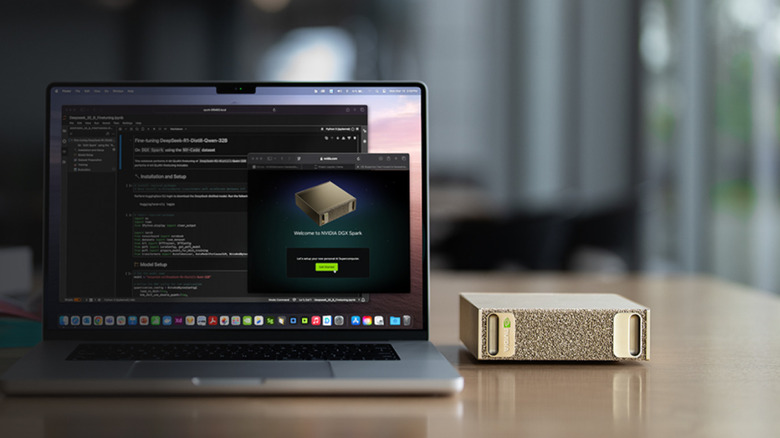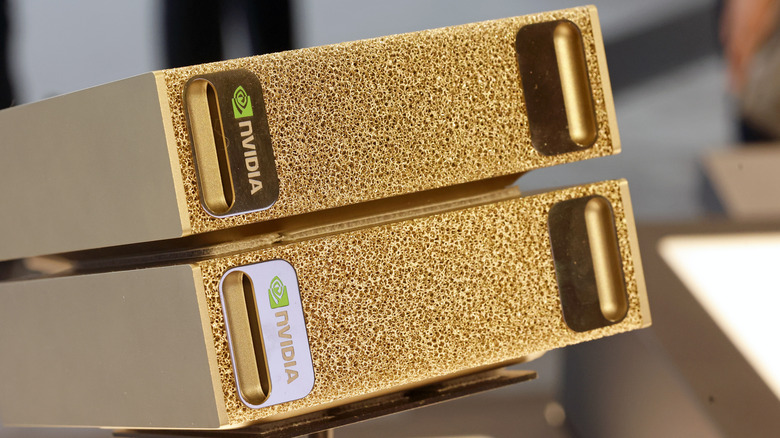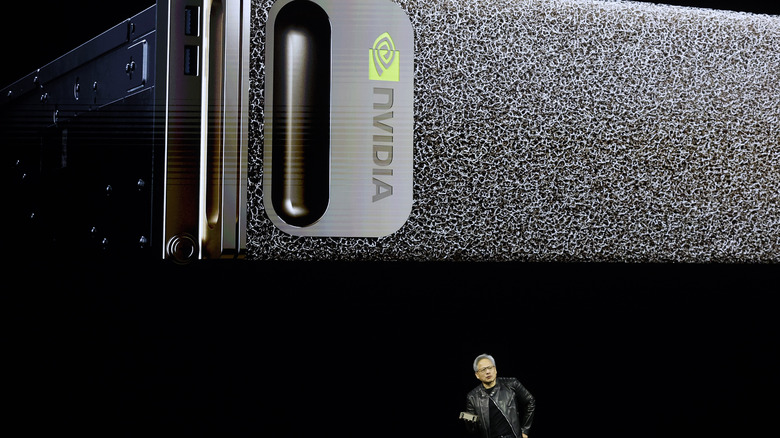The 'World's Smallest Supercomputer' Is Here – And Elon Musk Is One Of The First Owners
When you think of supercomputers, you probably think of vast air-controlled rooms crammed full of cabinets and illuminated by banks of flashing LEDs. The first Cray supercomputer, for instance, cost $10 million, contained 60 miles of wiring, and drew enough power to power ten homes, but it also weighed in at over 5 tons. In performance terms, the Cray 1 was capable of a peak speed of 160 megaflops (a megaflop being a measure of computer performance equal to one million floating points per second).
If you wanted to have one of these installed, a team of engineers would spend up to a year installing the wiring, the cooling systems, the system disk subsystem, and the workstations. Five decades later, Nvidia CEO Jensen Huang simply walked up to Elon Musk and hand-delivered a signed model of the company's latest supercomputer — the DGX Spark. This is a supercomputer that's about the same size as a hardback book and has a performance of one petaflop.
As opposed to counting the price in millions of dollars, the Nvidia DGX Spark also comes in at a more realistic cost of $3,999, although personal delivery by Mr. Huang is presumably not included in this price. What is included is the GB10 Grace Blackwell superchip. This is the beating heart of the system, and comprises a Blackwell generation GPU and a 20-core ARM CPU. As an aside, the latest generation of Nvidia graphics cards is based on the Blackwell architecture.
Nvidia DGX Spark - A pocket-sized supercomputer
Before we look at the DGX Spark, it's useful to gain a little grounding in the Nvidia DGX platform. DGX stands for "Deep GPU Xceleration" and is Nvidia's dedicated platform for enterprise AI workloads. The platform is already in widespread use throughout industry and other sectors, including powering AI systems for the top ten global car manufacturers and the top ten global universities. The DGX Spark is the latest hardware addition to the platform.
As such, it's probably a disappointment to the gamers and video-editors thinking the DGX Spark had made their dreams of the ultimate performance PC come true. Nevertheless, it does boast some pretty impressive stats. Apart from the Blackwell superchip supplying the petaflop performance, the DGX Spark also features 128 GB of unified RAM (CPU and GPU) and high-speed Nvidia ConnectX networking. At this stage, it's worth remembering that all this fits in a package with a width and length of just under six inches each, a height of two inches, and weighs about 2.5 pounds.
The Spark runs on Nvidia's DGX OS, which will be unfamiliar to most of us. However, the back of the computer does return to some level of familiarity, with four USB-C ports (one for power), an HDMI port, an Ethernet port, and two QSFP ports. The latter are Quad Small Form-factor Pluggable ports and are used for data-intensive systems like servers, switches, and, of course, AI supercomputers.
From room-sized giants to desktop powerhouses
We began by comparing the DGX Spark with the original Cray 1 supercomputer (though this is somewhat unfair to the Cray), which remains one of the most remarkable computers ever built. What this did show is just how far technology has progressed in just a few decades. A more reasonable comparison that shows more recent technological advancements would be to compare the DGX Spark with the DGX-1, Nvidia's first foray into the AI supercomputer niche, which it released in 2016.
The DGX-1 was the world's first supercomputer dedicated to meeting the growing computing demands of AI. The computer had a peak performance of 170 teraflops and was powered by Nvidia Tesla P100 GPUs. While it wasn't the size of a room, it was substantially larger than the DGX Spark, with dimensions of 34.1 by 17.48 inches with a height of over 5 inches. It also costs substantially more, with a price tag of $129,000. In a quirk of history, the first DGX computer was delivered to OpenAI when Elon Musk was with the company.
In less than a decade, Nvidia has managed to shrink an enterprise-grade AI system into a device that costs just a few thousand dollars and fits easily into a backpack. For those interested, the DGX Spark went on sale on 15 October and is available from the Nvidia website.


